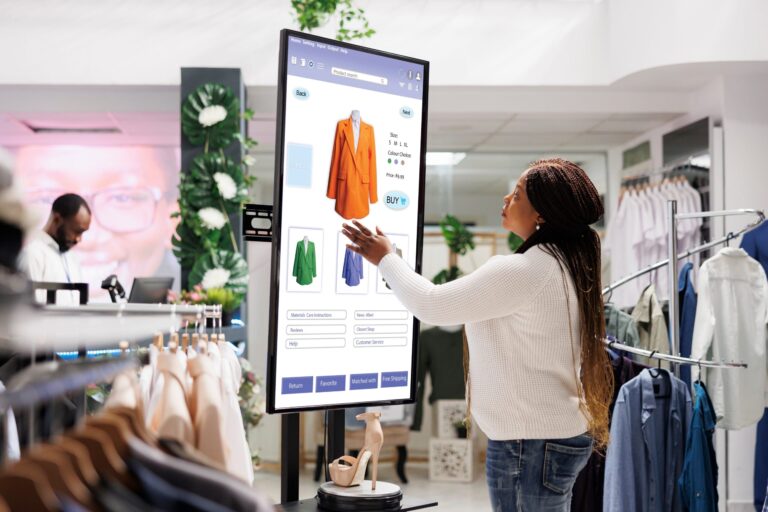The evolution of retail has seen a strong surge in retail media networks (RMNs) over recent years, reshaping the way brands interact with consumers. Digital advertising in online retail is often top of mind, yet in-store retail media networks are now emerging as a powerful force.
By delivering dynamic and contextually relevant content to shoppers in physical stores, RMNs leverage in-store digital tools—like displays, kiosks, and smart shelves—to provide a tailored experience at the point of decision making. In 2024, in-store RMNs have proven their value, and as we look towards 2025, these networks are expected to be even more impactful in improving shopper experiences and driving store revenues.
What Are In-Store Retail Media Networks?
In-store retail media networks are digital ecosystems within brick-and-mortar stores, delivering targeted advertisements and brand messaging to shoppers as they navigate the aisles. Examples of RMN formats include:
- Digital Signage: Large displays located throughout the store, promoting products and offers in real time.
- Smart Shelves and End Cap Displays: LED screens near products displaying information, pricing, and promotions to inform shoppers at the shelf.
- In-Store Kiosks: Interactive stations allowing customers to search for items, view promotions, or watch ads for specific products.
- Digital Shelf Edge displays: Dynamic labels with full color branding and motion that update pricing and promotions instantly on store shelves.
These in-store formats bridge the digital and physical shopping worlds, empowering retailers to reach customers where purchase decisions are made.
Why In-Store Retail Media Networks Are Relevant
Despite the rise of e-commerce, in-store RMNs have remained relevant by delivering benefits that resonate with consumers and retailers alike. Here are the core reasons for their ongoing success and importance:
1. In-Store Shopping Is Not Going Away
Shoppers are still drawn to physical stores for the tangible experiences they offer, from testing products in person to receiving immediate purchase gratification. RMNs enhance this experience by delivering real-time, contextually relevant content, aligning with consumer behavior and providing added value in the store.
2. Capturing Last-Minute Purchase Decisions
Retailers have long recognized that a large portion of buying decisions are made in-store. RMNs harness this by promoting related products and offers at critical moments, potentially increasing cart sizes and influencing purchase behavior right at the shelf. This capability is particularly impactful in categories where impulse buys are common, such as grocery or health and beauty.
3. Real-Time Adaptability
One of the most compelling features of RMNs is their flexibility. Retailers and brands can adjust messaging and promotions instantly in response to factors like current stock levels, time of day, or even local events. This adaptability creates highly personalized experiences that boost engagement and drive sales, placing RMNs in a unique position to show the right ad in the right place at precisely the right time.
4. Data-Driven Personalization
Data-driven insights from digital touchpoints help retailers tailor the in-store experience just as effectively as online ads. By using shopper data, RMNs can customize messages to individual preferences, guiding shoppers to products they may find relevant. This level of personalization not only enhances the customer experience but also increases the likelihood of conversion, blending the precision of digital advertising with the immediacy of physical retail. Increasingly, shoppers are reaping the benefits of loyalty memberships, allowing retailers to have a wealth of data about preferences and behaviors. This data-driven hyper-targeted personalization enhances RMNs along every point in the shopper journey.
5. Enhanced Measurement and ROI
As technology advances, retailers can better measure RMN impact on shopper behavior and sales. With in-store analytics, foot traffic patterns, and engagement metrics, retailers are now empowered to quantify their RMN investment and refine strategies based on real-time data. This data-driven approach optimizes the return on investment and ensures campaigns are continually refined for effectiveness.
The Future of In-Store Retail Media Networks
As we look ahead to 2025, in-store RMNs are primed to gain even more traction. According to IPG Mediabrands, global retail media ad spend is expected to reach approximately $165.9 billion in 2025, up from $140 billion in 2024, reflecting an annual growth rate of around 21.8%. To thrive in this evolving landscape, retailers should consider innovative, comprehensive RMN solutions that integrate seamlessly into the store environment while offering flexibility and scalability.
Why Partner With STRATACACHE?
STRATACACHE stands at the forefront of in-store RMN technology, providing solutions that elevate the shopper experience and drive results for retailers. STRATACACHE’s platform offers a variety of advanced, adaptable in-store digital tools—such as real-time content delivery, data integration, and scalable digital signage systems—allowing retailers to deploy cohesive and impactful RMNs across their entire network of stores.
With STRATACACHE, retailers gain:
- Seamless Integration: STRATACACHE’s solutions work with existing store technologies, ensuring smooth deployment and reducing setup costs.
- Scalable Technology: STRATACACHE provides a platform that grows with the business, enabling retailers to expand their RMN footprint easily as their needs evolve.
- Data-Driven Insights: Real-time data capabilities allow retailers to measure campaign performance and make adjustments on the fly, maximizing engagement and revenue impact.
In-store retail media networks represent a unique opportunity for retailers to connect with customers in ways that online channels cannot replicate. The value of RMNs extends beyond simple advertising—they create engaging, responsive, and data-backed in-store experiences that resonate with shoppers and drive sales. As the retail industry continues to evolve, in-store RMNs are set to be a key component of a retailer’s omnichannel strategy in 2025, merging the best of digital and physical worlds for maximized impact.

